
Guy Robertson and Adam Russell have made the first repeat of The Wailing Wall (IX 9) on An Teallach - Bidein a' Ghlas Thuill (Hayfork Wall). The line was established onsight in December 2010 by the late Martin Moran with Murdoch Jamieson.
Inspired by Martin's description of the climb during a conversation some years ago, Guy swiftly added The Wailing Wall to his to-do list. Guy told UKC:
"Martin Moran's Scottish winter climbing legacy is a treasure for us all to enjoy. His own first ascents, his guiding company's exploits and, of course, his writings on the subject, will undoubtedly continue to inspire us all for generations to come. So when he told me that a certain cliff, and a certain route, were in his view amongst the very best on offer, I just had to go and investigate. Martin's words encouraged an exploratory visit to An Teallach's magnificent Hayfork Wall, and the love affair commenced."
Accessing the base of the route - which sits at around 3,000ft - involves little snow and ice. The crag 'sits firmly in the modern idiom,' as Guy describes it, formed of steep, compact and 'wonderfully filthy' Torridonian Red sandstone. He commented:
"The lines are strong, the climbing hard and sustained, and the positions are truly sensational. There's also something uniquely Scottish about mixed climbing out and onto the side wall of a gully – one only has to think of West Central Gully Wal on Beinn Eighe, or Central Gully Wall on the Dubh Loch to draw parallels in terms of style and stature."
If the wall were made of clean granite, it would be "the preserve of the Extreme rock climber," Guy believes.
Martin Moran predicted that the crag would become one of Scotland's best modern mixed climbing venues. To date, Guy has only completed four routes over seven trips, which he says gives some clue as to the character of the crag:
"This is an adventurous place, with no summer lines and exclusively hard routes, which until now have seen very few if any repeats. Reputations of routes remain to be built."
The neighbouring hard lines are The Forge (X 10) (UKC News) and Local Hero (VIII 9), both FAs by Guy and Greg Boswell; The Silver Fox (VII 8) by Martin Moran and The Flying Fox (VIII 8) by Callum Johnson and Tim Miller.
Wailing Wall is the first route to breach the sheer and compact area of rock on the upper right side of the cliff. It was the line Martin spoke most highly of in terms of both quality and difficulty. Guy said:
"At grade IX,9, he had suggested that this was his hardest (as well as one of his best) routes to date. I was immediately intrigued – I knew from bitter experience that this man didn't hand out big numbers easily, and a route at such a high standard effectively finding the easiest way up a large area of cliff is a rare thing indeed."
On 9 January, Guy teamed up with Adam Russell to take a look, while Hamish Frost and Ryan Balharry joined to take photographs. Due to the pandemic, neither Guy nor Adam had climbed anything hard in the last two years. Guy commented:
"Reaching straight for the top shelf on an unrepeated grade IX was inevitably a bit of a big ask. There was a feeling, however, that this particular climb was something special, and that – and I paraphrase our banter on the approach – "the intoxicating effects of quality would win out over the numbing reality of difficulty!"
The team were met with perfect weather and conditions at the base, but their lack of recent hard climbing mileage weighed on Guy's mind. He said:
"I had a few quiet words to myself. Something along the lines that it was mostly a slab; not a patch on those forearm-pumping repeater circuits on the 40 degree board. If Martin was psyched enough to forge through the initial steepness and get involved in the main wall, then so should I be. The fact that he was a much more accomplished, experienced, cunning and consummate mountaineer than I'll ever be was a minor detail I chose to ignore!"
Wailing Wall is a route for "the true winter connoisseur", in Guy's opinion. He described the climbing as follows:
"An easy start up turf soon leads to an 8m horizontal ledge shuffle to the start of the main difficulties. A crack in the smooth wall some 10m above sports some vague sloping snow patches and discernible turf, but the wall barring access overhangs considerably. The gear isn't perfect, and as with all North West sandstone routes on big 'winter only' cliffs, the threat of detachable rock is always lurking menacingly. An assured and powerful approach is required. There are no footholds worth mentioning, only shallow vertical mossy seams. A series of deep and committing lock-offs on poor torques is effected to eventually reach the crack above. The considerable horizontal separation distance from the belay at this point undoubtedly heightens the anxiety. Above this bulging crux section, established above the lip, sinker axe placements and good protection soon arrive and allow the spectacular exposure to be savoured at last – the sweep of the gully yawning below, nothing but smooth and compact rock above.
"The rest of the first pitch goes like a dream – never easy, but mostly positive, and with the way not entirely obvious until the main soaring crack line on the left side of the wall is reached. This itself provides a more conventional tussle with poor feet but good hooks and even the odd Thank God hand jam. Protection is close to perfect."
Describing the 'feel' of the climb, Guy added: "It's a lonely place, with an atmosphere more commonly associated with hard rock climbing than winter scratching."
Adam took the lead on the second pitch. Guy explained:
"Above the belay block, some more strenuous lock-offs lead to a sustained and tenuous series of thin flakes and cracked grooves, always trending leftwards above the lip of a great overhung niche. The exposure here is once again quite stupendous, building slowly with every move, and with protection again thankfully remaining in plentiful supply."
With last light fading, an awkward and precarious finish up a series of steep and flared torquing cracks soon led the pair to easier ground. Guy summed up their repeat by reflecting once again on Martin Moran's pioneering legacy:
"Days like this are relatively few and far between; enjoying a relatively comfortable ride on a hard and mystical route. Good people, good form, good conditions and good choices align in a way that suggests certain forces beyond our control may be at work. Or maybe we're just plain lucky. There's a sense of magic in the bright, frigid air and stark moon shadows that dance around us up on the ridge, as we laugh and coil the ropes. It's a wonderful reminder of what we've all been missing over the past couple of winters, and the fantastic legacy the great pioneers like Martin leave behind."












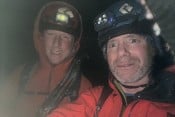


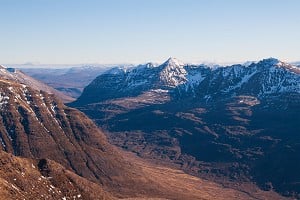
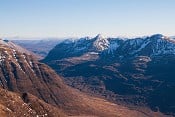


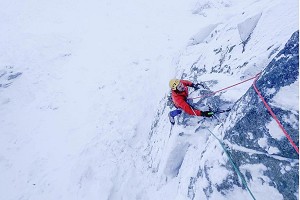
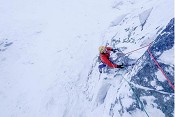
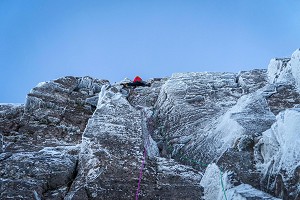
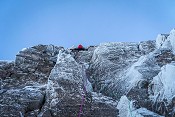
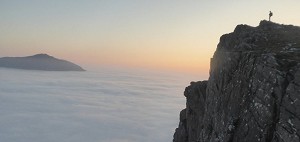

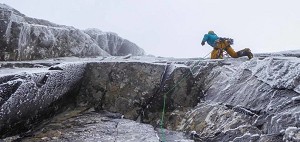

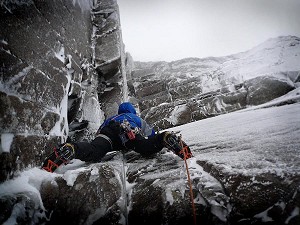
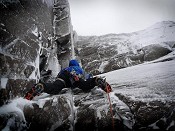
Comments
Blimey almost makes me want to do some winter climbing!! Great stuff.
Lovely tribute to Martin Moran.
Inspiring stuff.
What is the reason for there being no summer lines on this cliff?
Si.
That kind of sandstone doesn't lend itself well to rock routes really. It's blocky, loose, wet, vegetated, dirty etc.
The rock routes in that part of Scotland tend to be on Quartzite. You won't find many rock routes on the Torridonian giants.
It also doesn't see a lot of sunlight, it's in a very recessed position.